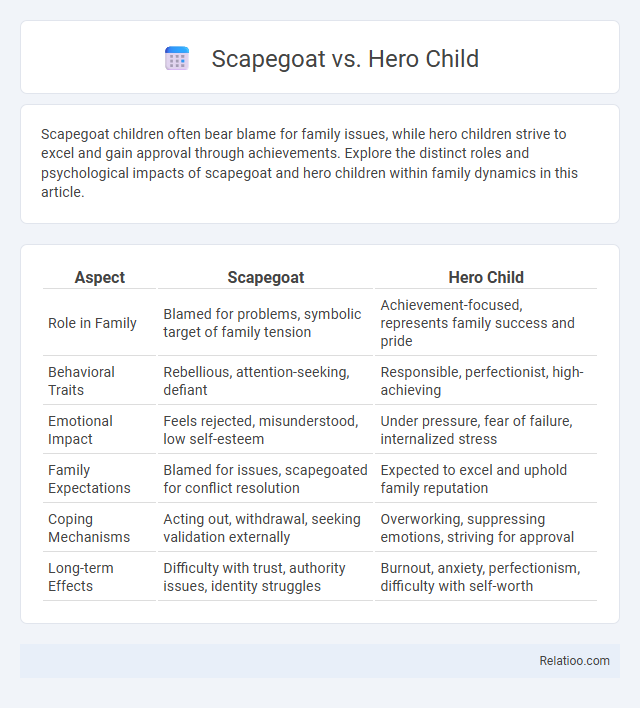Scapegoat children often bear blame for family issues, while hero children strive to excel and gain approval through achievements. Explore the distinct roles and psychological impacts of scapegoat and hero children within family dynamics in this article.
Table of Comparison
| Aspect | Scapegoat | Hero Child |
|---|---|---|
| Role in Family | Blamed for problems, symbolic target of family tension | Achievement-focused, represents family success and pride |
| Behavioral Traits | Rebellious, attention-seeking, defiant | Responsible, perfectionist, high-achieving |
| Emotional Impact | Feels rejected, misunderstood, low self-esteem | Under pressure, fear of failure, internalized stress |
| Family Expectations | Blamed for issues, scapegoated for conflict resolution | Expected to excel and uphold family reputation |
| Coping Mechanisms | Acting out, withdrawal, seeking validation externally | Overworking, suppressing emotions, striving for approval |
| Long-term Effects | Difficulty with trust, authority issues, identity struggles | Burnout, anxiety, perfectionism, difficulty with self-worth |
Understanding Family Roles: Scapegoat vs Hero Child
In family dynamics, the scapegoat is often assigned blame for problems, serving as a distraction from deeper issues, while the hero child strives to gain approval through achievements and responsibility. Understanding the distinction between these roles is essential for recognizing patterns of dysfunction, where the scapegoat's behavior may mask emotional pain and the hero child's perfectionism hides vulnerability. Addressing these roles helps create healthier communication and emotional balance within the family system.
Defining the Scapegoat Child
The scapegoat child is defined as a family member who is unfairly blamed for problems and conflicts, often taking the fall for dysfunctional dynamics. Unlike the hero child, who seeks approval through achievement and compliance, the scapegoat child typically exhibits rebellious or acting-out behaviors as a response to misplaced guilt and family stress. Scapegoating involves projecting collective family issues onto one child, which disrupts healthy emotional development and perpetuates negative self-perception.
Characteristics of the Hero Child
The Hero Child is characterized by high achievement, responsibility, and a strong desire to gain approval from parents or authority figures. Often taking on mature roles prematurely, they strive to bring positive attention to the family by excelling in academics, sports, or other activities. This role contrasts with the Scapegoat, who draws negative attention, while Scapegoating involves unfairly blaming a family member for problems or conflicts.
Origins of Dysfunctional Family Roles
Dysfunctional family roles such as the scapegoat, hero child, and scapegoating often originate from unresolved trauma, neglect, or addiction within the family system. Scapegoating emerges as a coping mechanism where one member is unfairly blamed to divert attention from deeper issues, while the hero child assumes responsibility to maintain family stability and earn approval. Understanding these dynamics helps you identify patterns and promotes healing by addressing the root causes of dysfunction rather than just the symptoms.
Psychological Impact on the Scapegoat
The psychological impact on the scapegoat child in dysfunctional families often results in chronic low self-esteem, anxiety, and difficulty trusting others due to persistent blame and rejection. Compared to the hero child, who may internalize pressure to overperform, the scapegoat faces emotional neglect and scapegoating trauma that can lead to identity confusion and depression. Effective therapeutic interventions focus on breaking cycles of scapegoating by fostering self-compassion, resilience, and healthy boundaries.
Long-Term Effects on the Hero Child
The long-term effects on the hero child within scapegoating family dynamics often include chronic anxiety, perfectionism, and a compulsive need to please others to maintain family stability. These individuals may develop unhealthy coping mechanisms, such as emotional suppression and difficulty setting boundaries, which can lead to burnout and identity confusion in adulthood. Persistent scapegoating roles hinder the hero child's authentic self-expression and contribute to ongoing struggles with self-worth and interpersonal relationships.
Coping Mechanisms and Survival Strategies
The Scapegoat role often copes with family dysfunction by absorbing blame, developing resilience through externalizing problems and seeking validation outside the family unit. Hero Children adopt coping mechanisms centered on achievement and perfectionism, striving to gain approval and maintain family stability by taking responsibility for success. Scapegoating as a survival strategy involves diverting familial stress towards one member, which can lead you to internalize guilt but also develop strong adaptive skills to navigate emotional turmoil.
Breaking Free from Assigned Roles
Breaking free from assigned roles like Scapegoat, Hero Child, or scapegoating dynamics requires recognizing and challenging the limiting narratives imposed within family systems. Therapeutic interventions such as cognitive-behavioral therapy and family systems therapy are effective in dismantling these entrenched roles by fostering self-awareness and promoting individual identity development. Empowerment through setting boundaries, reframing self-perception, and cultivating emotional resilience plays a crucial role in transcending dysfunctional patterns.
Healing and Recovery for Scapegoats and Hero Children
Scapegoats and Hero Children often bear emotional burdens within dysfunctional family systems, where scapegoating assigns blame unfairly, impacting your self-worth and mental health. Healing and recovery involve recognizing these roles, setting boundaries, and seeking therapy to reframe negative self-perceptions and restore personal empowerment. Therapeutic interventions such as cognitive-behavioral therapy (CBT) and support groups promote resilience, enabling scapegoats and hero children to break free from maladaptive patterns and develop a healthier identity.
Building Healthy Family Dynamics
Understanding the roles of scapegoat, hero child, and scapegoating is essential for building healthy family dynamics. Recognizing how scapegoating can create tension and harm emotional well-being allows you to address imbalances and foster empathy among family members. Encouraging open communication and validating each person's experiences helps replace dysfunctional patterns with supportive interactions that promote collective healing and growth.

Infographic: Scapegoat vs Hero Child
 relatioo.com
relatioo.com